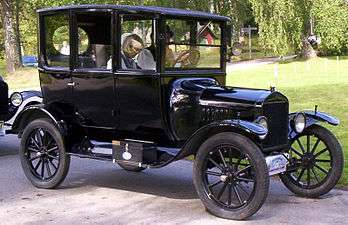Weaverland Old Order Mennonite Conference

.png)
The Weaverland Conference, also called Horning Church or Black-bumper Mennonites is a Christian denomination of Old Order Mennonites who use cars.
Names
The popular name Horning Church came from Bishop Moses Horning, who owned a car bought for him by a parishioner.[1] The group is also known as Black-bumper Mennonites for their early custom of painting over the chrome on their cars for modesty, though in the modern day this custom is only mandatory for ministers[1]
History
The Weaverland Old Order Mennonite Conference emerged from the Old Order division, that occurred in 1893 in Lancaster County, Pennsylvania over the question of English language preaching, Sunday Schools and other questions. The trigger for the split was the a quarrel about a pulpit, that was to be installed in church instead of the traditional preacher's table.[2]
There was another split in 1927 over disagreements over the use of automobiles. The Weaverland Mennonite then allowed the use of cars, but only with black bumpers. Those opposed to car usage formed a new church, the Groffdale Conference Mennonite Church, also called Wenger Mennonites. The remainder of the Weaverland Conference since then have also been known as the Horning Church because their bishop in the time of the split was Moses G. Horning (1871-1955) or "Black-bumper Mennonites" for their past custom of purchasing cars but covering up the flashy chrome with black paint.[3] [1]
Customs and beliefs
Weaverland Conference Mennonites are dressed plain. They used to speak Pennsylvania German, but it is no longer used in church services and there has generally been a shift to the English language in daily life. Older members of the church still speak Pennsylvania German.[4]
Ideologically this group shares many similar beliefs with Conservative Mennonites though differing in not having Sunday Schools or revival meetings. What characterize this automobile groups as Old Orders and not Conservative Mennonites is that they have retained the traditional forms of worship, communion, baptism, funeral and leadership structures. In contrast some wedding practices have changed.[5] They identify more with the values of the Old Order groups but share common core values or distinctives.
Membership and congregations
In 1927, after the Wenger Mennonites had left the congregation, there were about 500 baptized members in Weaverland Mennonite Conference and in 1957 there were 1,731 baptized members.[6] In 1994 the number of baptized members had risen to 4,767.[7] In 2008/9 membership was 7,100 in 40 congregations.[8]
Publishing
The Weaverland Conference publishes a number of booklets and tracts under the name Weaverland Mennonite Publications.
See also
Link
References
- 1 2 3 Donald B. Kraybill; James P. Hurd (1 September 2006). Horse-and-buggy Mennonites: hoofbeats of humility in a postmodern world. Penn State Press. pp. 73–. ISBN 978-0-271-02865-1. Retrieved 27 February 2011.
- ↑ Stephen Scott: An Introduction to Old Order: and Conservative Mennonite Groups, Intercourse, PA 1996, pages 20-24.
- ↑ Stephen Scott: An Introduction to Old Order: and Conservative Mennonite Groups, Intercourse, PA 1996, pages 29-31.
- ↑ Donald B. Kraybill (2010). Concise Encyclopedia of Amish, Brethren, Hurtterites and Mennonites. Johns Hopkins University Press. p. 247.
- ↑ Stephen Scott (1996). An Introduction to Old Order: and Conservative Mennonite Groups. Good Books, Intercourse, PA. p. 77.
- ↑ Old Order Mennonites at Global Anabaptist Mennonite Encyclopedia Online.
- ↑ Stephen Scott: An Introduction to Old Order: and Conservative Mennonite Groups, page 73
- ↑ Donald B. Kraybill (2010). Concise Encyclopedia of Amish, Brethren, Hurtterites and Mennonites. Johns Hopkins University Press. p. 258.